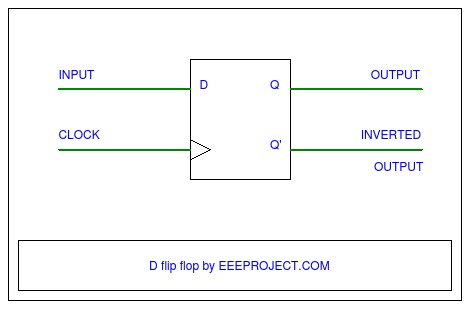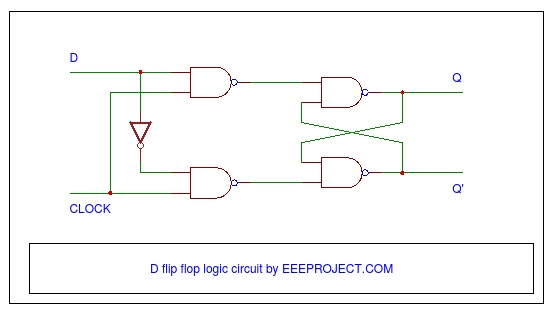D flip flop
D flip flop is one of the types in flip flops. It is very widely used in real world applications and many refer it as delay or data flip flop also.

What are Flip flop
Flip flop is one thing that you will definitely come across while studying Digital electronics. Flip flop is also called as latch and its main use is in the field of electronics. It is actually a kind of circuit with 2 stable states and the main usage of such a component is for storage of state related information. Its main property is that of being bi stable and having multi behavior. It is used in sequential logical arrangements such as in computers, digital electronics, communication based applications and much more. These are used for storing data and can be either simple or in clocked form. The circuit’s state in flip flop can be changed with the help of signals that are actually applied to the control inputs that may be one or more and will result in the output that may be one or two.
How D flip flop works?
The D flip flop will capture D input value and the portion being definite at the clock cycle. The value that has been ultimately captured will become the output denoted by Q. The output Q will not vary at other times. Thus for all these reasons the D flip flop is considered to be a memory cell and in other terms it is also referred as a delay line or one can say a zero order hold.

TRUTH TABLE
| CLOCK | D | Q | Q’ |
|---|---|---|---|
| 0 | X | Q (Prev) | Q’ (Prev) |
| 1 | 1 | 1 | 0 |
| 1 | 0 | 0 | 1 |
Some crucial information about D flip flop
Very much similar to the SR flip flop many D flip flops in the ICs have the potential to be managed to the set as well as reset state. In the D type flip flops the illegal condition of S=R=1 is basically resolved. And with settings like S=R=0 the usability of this type of flip flop can be adjusted as per specifications.
Application of D flip flop
D flip flops turn out to be very useful in complimenting the shift registers and thus their importance in various electronic devices can’t be ignored at all. D flip flop has got an advantage over the D type transparent latch and that’s when a signal is received on the D input pin then it gets captured at the very moment and the flip flop will get clocked. Thus any further changes that will take place on the D input will not be taken into account until the starting of next clock event.
Exception in D flip flop
There is an exception that some D flip flops have signal input which can be reset and thus the Q can be reset to zero value. And depending on the case it may be synchronous or asynchronous as in accordance with the clock.
You may also like Sun Tracking Solar Panel
Types of D flip flop
If one classifies D flip flops then there can be multiple types of it. Some of them are like classical positive edge triggered D flip flop. The Master slave edge triggered D flip flop and edge triggered dynamic D storage element. Based on the specific usability these D flip flops are needed for customized purposes and for completion of specified tasks.
You may also like how to test a diode
